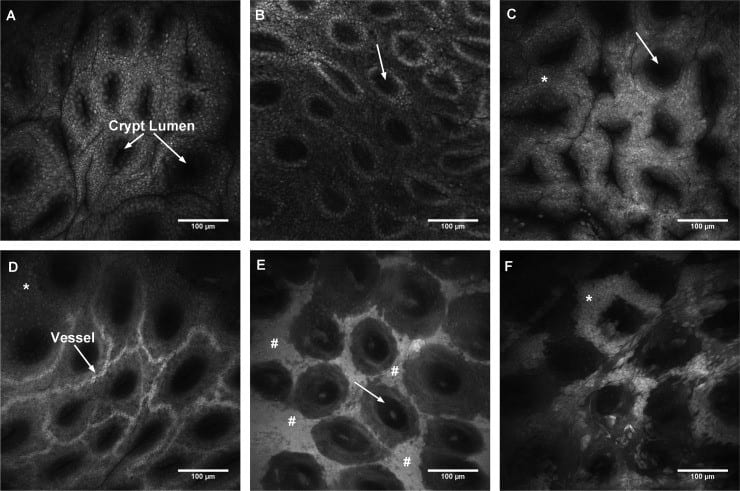Submitted by Dr. Gracie Vargas, Professor, Neuroscience Cell Biology & Anatomy and Director of the Advanced Bio-Optics Imaging Laboratory, University of Texas Medical Branch, Galveston, TX.
The biomedical engineering and women’s research teams headed by Drs. Massoud Motamedi, Dr. Gracie Vargas, and Dr. Kathleen Vincent at the University of Texas Medical Branch Center have a collective interest in image-based assessment of vaginal and rectal epithelial injury and inflammation. The occurrence of injury or inflammation is associated with potential compromise of the barrier function of the vaginal and rectal mucosal surfaces. Defects in barrier function or recruitment of target cells which may occur with inflammation or healing of injuries are of concern as they could increase risks for transmission and infection by HIV and other pathogens. Furthermore, there is a paucity of methods that can provide indication of vaginal and rectal epithelial injury and inflammation in vivo or in real time, and, in particular, to detect and monitor mucosal health in response to topical or systemic drugs aimed for prevention of infection. This remains true not only for monitoring of effects in humans but also as tools in the development of preventive approaches in small and large animal models.
For the last several years, this collective team of biomedical engineers and women’s studies researchers have led efforts to 1) understand the mucosal changes associated with the use of topical, systemic, or device-delivery of HIV prevention agents and 2) identify markers, including image-based markers of inflammation and injury to these surfaces. Image tools that have been central to our efforts have included the real-time optical imaging tools of confocal endomicroscopy [1-3] and optical coherence tomography [4-5].
Confocal endomicroscopy used in this research has included use of the OptiScan FIVE.1 confocal endomicroscope [1,2] and most currently, the ViewnVivo (FIVE.2) endomicroscope. These in vivo microscopes have allowed for rapid and longitudinal imaging of the vaginal and rectal mucosa in a large animal model used in our studies. In vivo microscopy has allowed identification of surface structural and functional features that indicate injury or compromise (Figure 1). Furthermore, with appropriate staining, inflammatory infiltrates may be identified and potentially used to monitor presence of inflammation and impact on mucosal health. Our group anticipates this tool to continue to be a valuable component of our studies in women’s health and HIV prevention.
Figure 1: Features of the ovine rectal mucosa identified prior to and following epithelial disruption from topical agents. Panels A-D show structural features made possible from a topical dye (Acriflavine) while E-F show compromise of the barrier function through leakage of a paracellular dye (NaFl).
{From: Vargas G, Vincent KL, Zhu Y, Szafron D, Brown TC, Villareal PP, Bourne N, Milligan G, Motamedi M, In vivo rectal mucosal barrier function imaging in a large animal model using confocal endomicroscopy: implications for injury assessment and use in HIV prevention studies, Antimicrobial Agents and Chemotherapy, 2016 May 16. pii: AAC.00134-16.}
Professor
University of Texas Medical Branch

Professor
University of Texas Medical Branch

Associate Professor
University of Texas Medical Branch

References:
1.Vargas G, Patrikeev I, Wei J, Bell B, Vincent K, Bourne N, Motamedi M, Quantitative assessment of microbicide-induced injury in the ovine vaginal epithelium using confocal microendoscopy, BMC Infectious Diseases 2012, 12:48 (29 February 2012) PMID: 2237579
2.Vargas G, Vincent KL, Zhu Y, Szafron D, Brown TC, Villareal PP, Bourne N, Milligan G, Motamedi M, In vivo rectal mucosal barrier function imaging in a large animal model using confocal endomicroscopy: implications for injury assessment and use in HIV prevention studies, Antimicrobial Agents and Chemotherapy, 2016 May 16. pii: AAC.00134-16.
3.Vargas G, Vincent KL, Wei J, Bourne N, Motamedi M, Topical injury evaluation of the murine colorectal mucosa using confocal endomicroscopy: a valuable method for assessing mucosal injuries associated with risk of pathogen transmission, J Microsc. 2016 Jun 28. doi: 10.1111/jmi.12438. [Epub ahead of print] PMID: 27351717
4.Vincent, K.L., G. Vargas, J. Wei, N. Bourne and M. Motamedi, Monitoring vaginal epithelial thickness changes noninvasively in sheep using optical coherence tomography. American journal of obstetrics and gynecology, 2013 Apr;208(4):282.
5.Vincent, K.L., G. Vargas, N. Bourne, V. Galvan-Turner, J. I. Saada, G. H. Lee, E. Sbrana and M. Motamedi, Image-Based Noninvasive Evaluation of Colorectal Mucosal Injury in Sheep After Topical Application of Microbicides. Sexually transmitted diseases, 2013. 40(11): p. 854-859.
